Comprehensive Nursing Case Study: Olive's Medical Management
VerifiedAdded on 2022/08/14
|12
|3474
|15
Case Study
AI Summary
This case study focuses on Olive, an elderly patient with a medical history of syncope and atrial fibrillation (AF), highlighting crucial nursing interventions. The document details Olive's medical background, including the diagnosis of AF and the concerns surrounding her anticoagulation therapy. It explores the significance of comprehensive risk assessments, including the A-G assessment tool and Glasgow Coma Scale, to evaluate Olive's condition and manage fall risks. The case study outlines essential nursing interventions, such as close observation, fall prevention strategies, and referrals to occupational and physical therapists. It further analyzes Olive's medication changes from warfarin to rivaroxaban, discussing the benefits and risks of each anticoagulant, as well as the implications of her medication regime. Moreover, the study delves into the importance of anticoagulation management during the intraoperative stage, emphasizing the need for careful preoperative risk analysis, and appropriate bleeding management. The case study also covers analgesic care, specifically the use of regional anesthesia for Olive's fracture, and the nursing interventions associated with the same. Overall, the case study provides a comprehensive overview of Olive's care, highlighting the importance of patient-centered interventions and evidence-based practice.
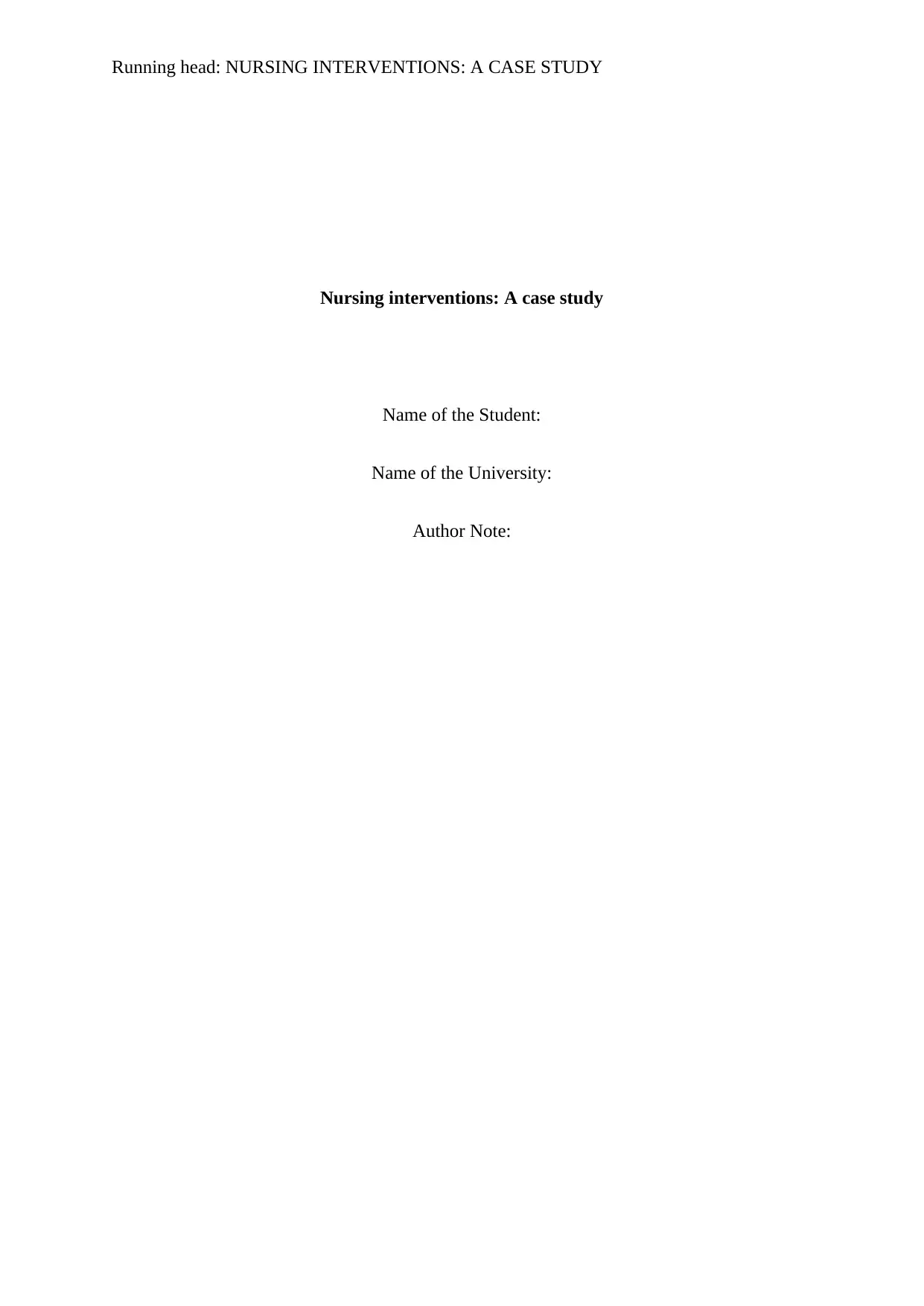
Running head: NURSING INTERVENTIONS: A CASE STUDY
Nursing interventions: A case study
Name of the Student:
Name of the University:
Author Note:
Nursing interventions: A case study
Name of the Student:
Name of the University:
Author Note:
Paraphrase This Document
Need a fresh take? Get an instant paraphrase of this document with our AI Paraphraser
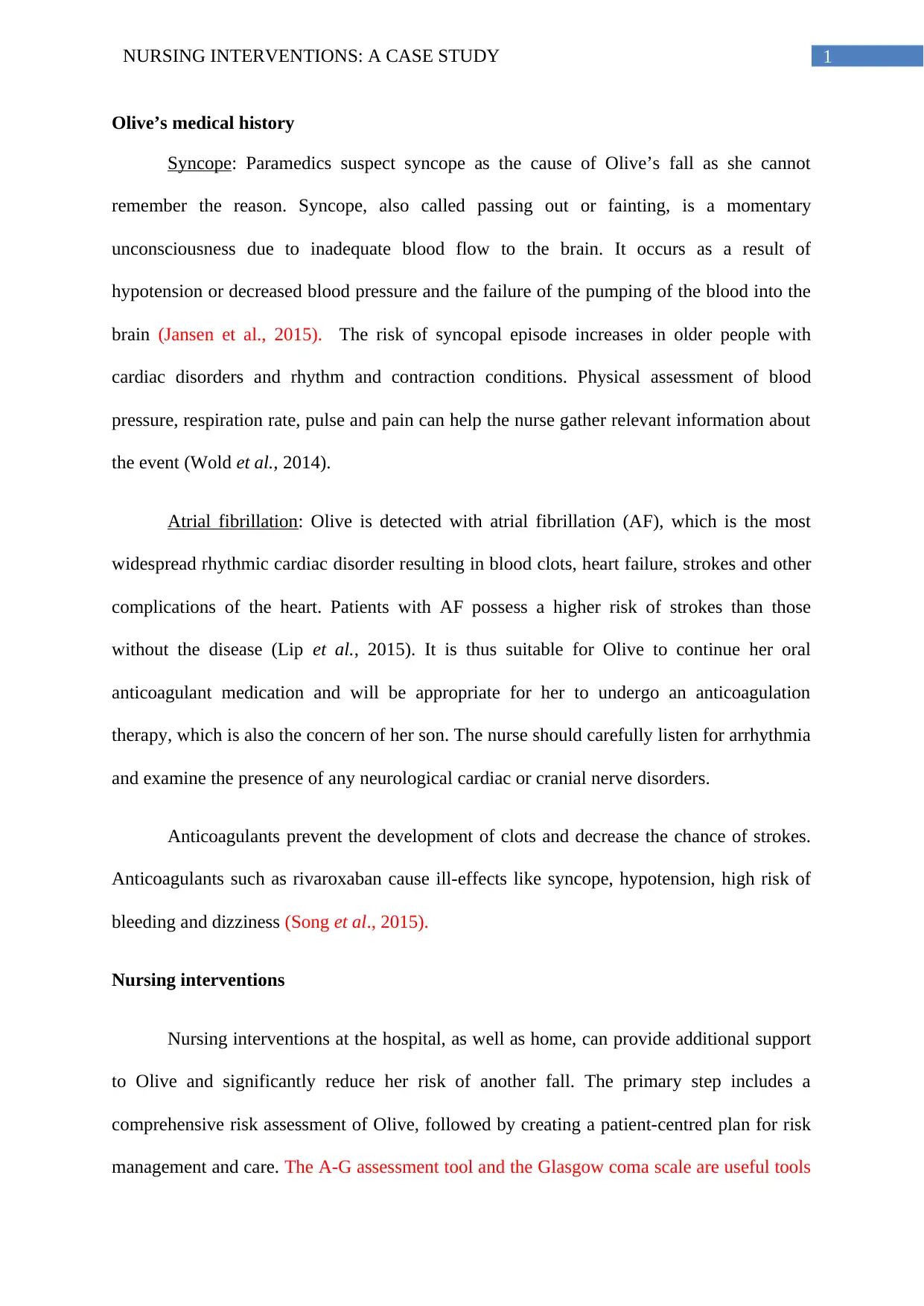
1NURSING INTERVENTIONS: A CASE STUDY
Olive’s medical history
Syncope: Paramedics suspect syncope as the cause of Olive’s fall as she cannot
remember the reason. Syncope, also called passing out or fainting, is a momentary
unconsciousness due to inadequate blood flow to the brain. It occurs as a result of
hypotension or decreased blood pressure and the failure of the pumping of the blood into the
brain (Jansen et al., 2015). The risk of syncopal episode increases in older people with
cardiac disorders and rhythm and contraction conditions. Physical assessment of blood
pressure, respiration rate, pulse and pain can help the nurse gather relevant information about
the event (Wold et al., 2014).
Atrial fibrillation: Olive is detected with atrial fibrillation (AF), which is the most
widespread rhythmic cardiac disorder resulting in blood clots, heart failure, strokes and other
complications of the heart. Patients with AF possess a higher risk of strokes than those
without the disease (Lip et al., 2015). It is thus suitable for Olive to continue her oral
anticoagulant medication and will be appropriate for her to undergo an anticoagulation
therapy, which is also the concern of her son. The nurse should carefully listen for arrhythmia
and examine the presence of any neurological cardiac or cranial nerve disorders.
Anticoagulants prevent the development of clots and decrease the chance of strokes.
Anticoagulants such as rivaroxaban cause ill-effects like syncope, hypotension, high risk of
bleeding and dizziness (Song et al., 2015).
Nursing interventions
Nursing interventions at the hospital, as well as home, can provide additional support
to Olive and significantly reduce her risk of another fall. The primary step includes a
comprehensive risk assessment of Olive, followed by creating a patient-centred plan for risk
management and care. The A-G assessment tool and the Glasgow coma scale are useful tools
Olive’s medical history
Syncope: Paramedics suspect syncope as the cause of Olive’s fall as she cannot
remember the reason. Syncope, also called passing out or fainting, is a momentary
unconsciousness due to inadequate blood flow to the brain. It occurs as a result of
hypotension or decreased blood pressure and the failure of the pumping of the blood into the
brain (Jansen et al., 2015). The risk of syncopal episode increases in older people with
cardiac disorders and rhythm and contraction conditions. Physical assessment of blood
pressure, respiration rate, pulse and pain can help the nurse gather relevant information about
the event (Wold et al., 2014).
Atrial fibrillation: Olive is detected with atrial fibrillation (AF), which is the most
widespread rhythmic cardiac disorder resulting in blood clots, heart failure, strokes and other
complications of the heart. Patients with AF possess a higher risk of strokes than those
without the disease (Lip et al., 2015). It is thus suitable for Olive to continue her oral
anticoagulant medication and will be appropriate for her to undergo an anticoagulation
therapy, which is also the concern of her son. The nurse should carefully listen for arrhythmia
and examine the presence of any neurological cardiac or cranial nerve disorders.
Anticoagulants prevent the development of clots and decrease the chance of strokes.
Anticoagulants such as rivaroxaban cause ill-effects like syncope, hypotension, high risk of
bleeding and dizziness (Song et al., 2015).
Nursing interventions
Nursing interventions at the hospital, as well as home, can provide additional support
to Olive and significantly reduce her risk of another fall. The primary step includes a
comprehensive risk assessment of Olive, followed by creating a patient-centred plan for risk
management and care. The A-G assessment tool and the Glasgow coma scale are useful tools
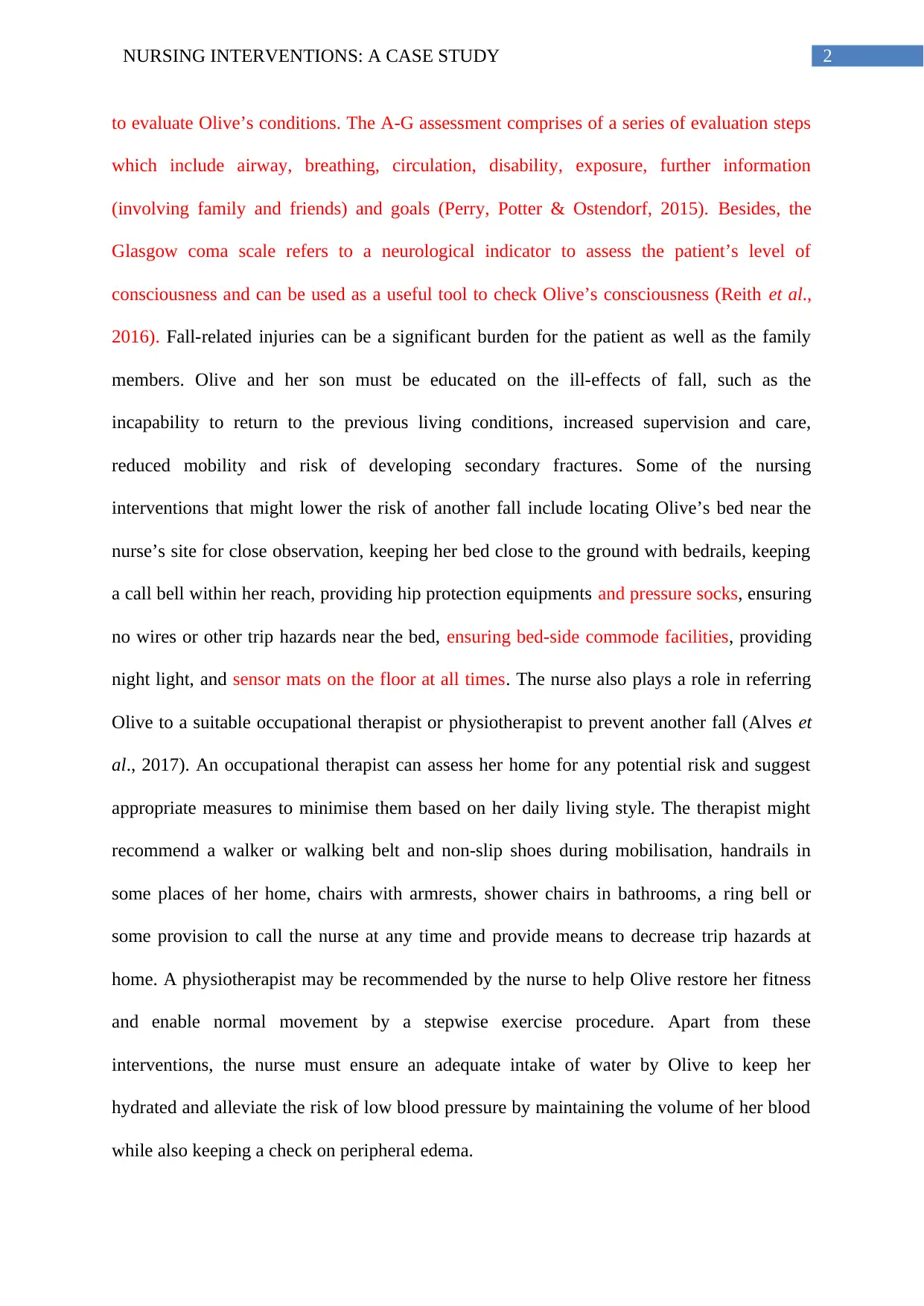
2NURSING INTERVENTIONS: A CASE STUDY
to evaluate Olive’s conditions. The A-G assessment comprises of a series of evaluation steps
which include airway, breathing, circulation, disability, exposure, further information
(involving family and friends) and goals (Perry, Potter & Ostendorf, 2015). Besides, the
Glasgow coma scale refers to a neurological indicator to assess the patient’s level of
consciousness and can be used as a useful tool to check Olive’s consciousness (Reith et al.,
2016). Fall-related injuries can be a significant burden for the patient as well as the family
members. Olive and her son must be educated on the ill-effects of fall, such as the
incapability to return to the previous living conditions, increased supervision and care,
reduced mobility and risk of developing secondary fractures. Some of the nursing
interventions that might lower the risk of another fall include locating Olive’s bed near the
nurse’s site for close observation, keeping her bed close to the ground with bedrails, keeping
a call bell within her reach, providing hip protection equipments and pressure socks, ensuring
no wires or other trip hazards near the bed, ensuring bed-side commode facilities, providing
night light, and sensor mats on the floor at all times. The nurse also plays a role in referring
Olive to a suitable occupational therapist or physiotherapist to prevent another fall (Alves et
al., 2017). An occupational therapist can assess her home for any potential risk and suggest
appropriate measures to minimise them based on her daily living style. The therapist might
recommend a walker or walking belt and non-slip shoes during mobilisation, handrails in
some places of her home, chairs with armrests, shower chairs in bathrooms, a ring bell or
some provision to call the nurse at any time and provide means to decrease trip hazards at
home. A physiotherapist may be recommended by the nurse to help Olive restore her fitness
and enable normal movement by a stepwise exercise procedure. Apart from these
interventions, the nurse must ensure an adequate intake of water by Olive to keep her
hydrated and alleviate the risk of low blood pressure by maintaining the volume of her blood
while also keeping a check on peripheral edema.
to evaluate Olive’s conditions. The A-G assessment comprises of a series of evaluation steps
which include airway, breathing, circulation, disability, exposure, further information
(involving family and friends) and goals (Perry, Potter & Ostendorf, 2015). Besides, the
Glasgow coma scale refers to a neurological indicator to assess the patient’s level of
consciousness and can be used as a useful tool to check Olive’s consciousness (Reith et al.,
2016). Fall-related injuries can be a significant burden for the patient as well as the family
members. Olive and her son must be educated on the ill-effects of fall, such as the
incapability to return to the previous living conditions, increased supervision and care,
reduced mobility and risk of developing secondary fractures. Some of the nursing
interventions that might lower the risk of another fall include locating Olive’s bed near the
nurse’s site for close observation, keeping her bed close to the ground with bedrails, keeping
a call bell within her reach, providing hip protection equipments and pressure socks, ensuring
no wires or other trip hazards near the bed, ensuring bed-side commode facilities, providing
night light, and sensor mats on the floor at all times. The nurse also plays a role in referring
Olive to a suitable occupational therapist or physiotherapist to prevent another fall (Alves et
al., 2017). An occupational therapist can assess her home for any potential risk and suggest
appropriate measures to minimise them based on her daily living style. The therapist might
recommend a walker or walking belt and non-slip shoes during mobilisation, handrails in
some places of her home, chairs with armrests, shower chairs in bathrooms, a ring bell or
some provision to call the nurse at any time and provide means to decrease trip hazards at
home. A physiotherapist may be recommended by the nurse to help Olive restore her fitness
and enable normal movement by a stepwise exercise procedure. Apart from these
interventions, the nurse must ensure an adequate intake of water by Olive to keep her
hydrated and alleviate the risk of low blood pressure by maintaining the volume of her blood
while also keeping a check on peripheral edema.
⊘ This is a preview!⊘
Do you want full access?
Subscribe today to unlock all pages.

Trusted by 1+ million students worldwide
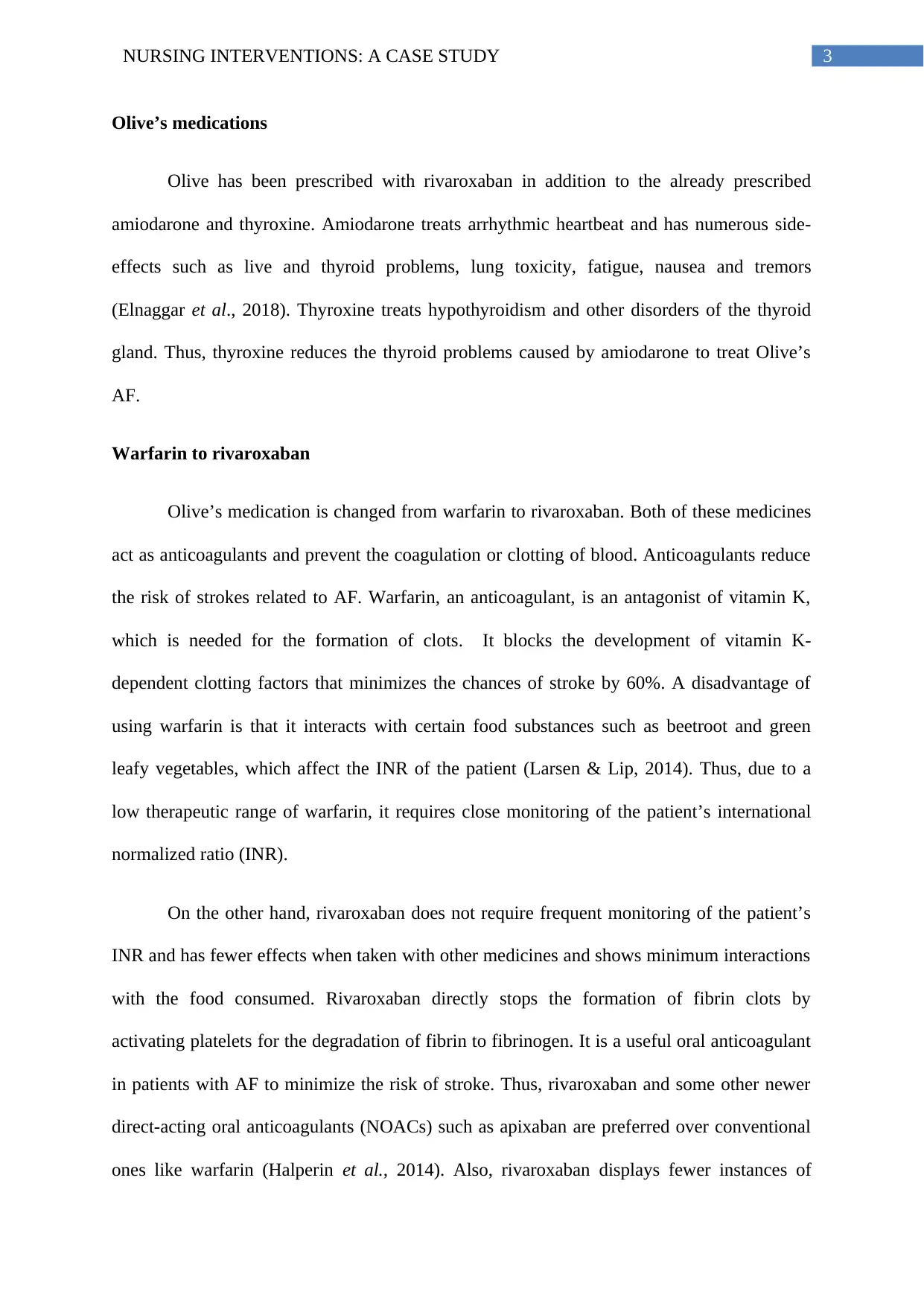
3NURSING INTERVENTIONS: A CASE STUDY
Olive’s medications
Olive has been prescribed with rivaroxaban in addition to the already prescribed
amiodarone and thyroxine. Amiodarone treats arrhythmic heartbeat and has numerous side-
effects such as live and thyroid problems, lung toxicity, fatigue, nausea and tremors
(Elnaggar et al., 2018). Thyroxine treats hypothyroidism and other disorders of the thyroid
gland. Thus, thyroxine reduces the thyroid problems caused by amiodarone to treat Olive’s
AF.
Warfarin to rivaroxaban
Olive’s medication is changed from warfarin to rivaroxaban. Both of these medicines
act as anticoagulants and prevent the coagulation or clotting of blood. Anticoagulants reduce
the risk of strokes related to AF. Warfarin, an anticoagulant, is an antagonist of vitamin K,
which is needed for the formation of clots. It blocks the development of vitamin K-
dependent clotting factors that minimizes the chances of stroke by 60%. A disadvantage of
using warfarin is that it interacts with certain food substances such as beetroot and green
leafy vegetables, which affect the INR of the patient (Larsen & Lip, 2014). Thus, due to a
low therapeutic range of warfarin, it requires close monitoring of the patient’s international
normalized ratio (INR).
On the other hand, rivaroxaban does not require frequent monitoring of the patient’s
INR and has fewer effects when taken with other medicines and shows minimum interactions
with the food consumed. Rivaroxaban directly stops the formation of fibrin clots by
activating platelets for the degradation of fibrin to fibrinogen. It is a useful oral anticoagulant
in patients with AF to minimize the risk of stroke. Thus, rivaroxaban and some other newer
direct-acting oral anticoagulants (NOACs) such as apixaban are preferred over conventional
ones like warfarin (Halperin et al., 2014). Also, rivaroxaban displays fewer instances of
Olive’s medications
Olive has been prescribed with rivaroxaban in addition to the already prescribed
amiodarone and thyroxine. Amiodarone treats arrhythmic heartbeat and has numerous side-
effects such as live and thyroid problems, lung toxicity, fatigue, nausea and tremors
(Elnaggar et al., 2018). Thyroxine treats hypothyroidism and other disorders of the thyroid
gland. Thus, thyroxine reduces the thyroid problems caused by amiodarone to treat Olive’s
AF.
Warfarin to rivaroxaban
Olive’s medication is changed from warfarin to rivaroxaban. Both of these medicines
act as anticoagulants and prevent the coagulation or clotting of blood. Anticoagulants reduce
the risk of strokes related to AF. Warfarin, an anticoagulant, is an antagonist of vitamin K,
which is needed for the formation of clots. It blocks the development of vitamin K-
dependent clotting factors that minimizes the chances of stroke by 60%. A disadvantage of
using warfarin is that it interacts with certain food substances such as beetroot and green
leafy vegetables, which affect the INR of the patient (Larsen & Lip, 2014). Thus, due to a
low therapeutic range of warfarin, it requires close monitoring of the patient’s international
normalized ratio (INR).
On the other hand, rivaroxaban does not require frequent monitoring of the patient’s
INR and has fewer effects when taken with other medicines and shows minimum interactions
with the food consumed. Rivaroxaban directly stops the formation of fibrin clots by
activating platelets for the degradation of fibrin to fibrinogen. It is a useful oral anticoagulant
in patients with AF to minimize the risk of stroke. Thus, rivaroxaban and some other newer
direct-acting oral anticoagulants (NOACs) such as apixaban are preferred over conventional
ones like warfarin (Halperin et al., 2014). Also, rivaroxaban displays fewer instances of
Paraphrase This Document
Need a fresh take? Get an instant paraphrase of this document with our AI Paraphraser
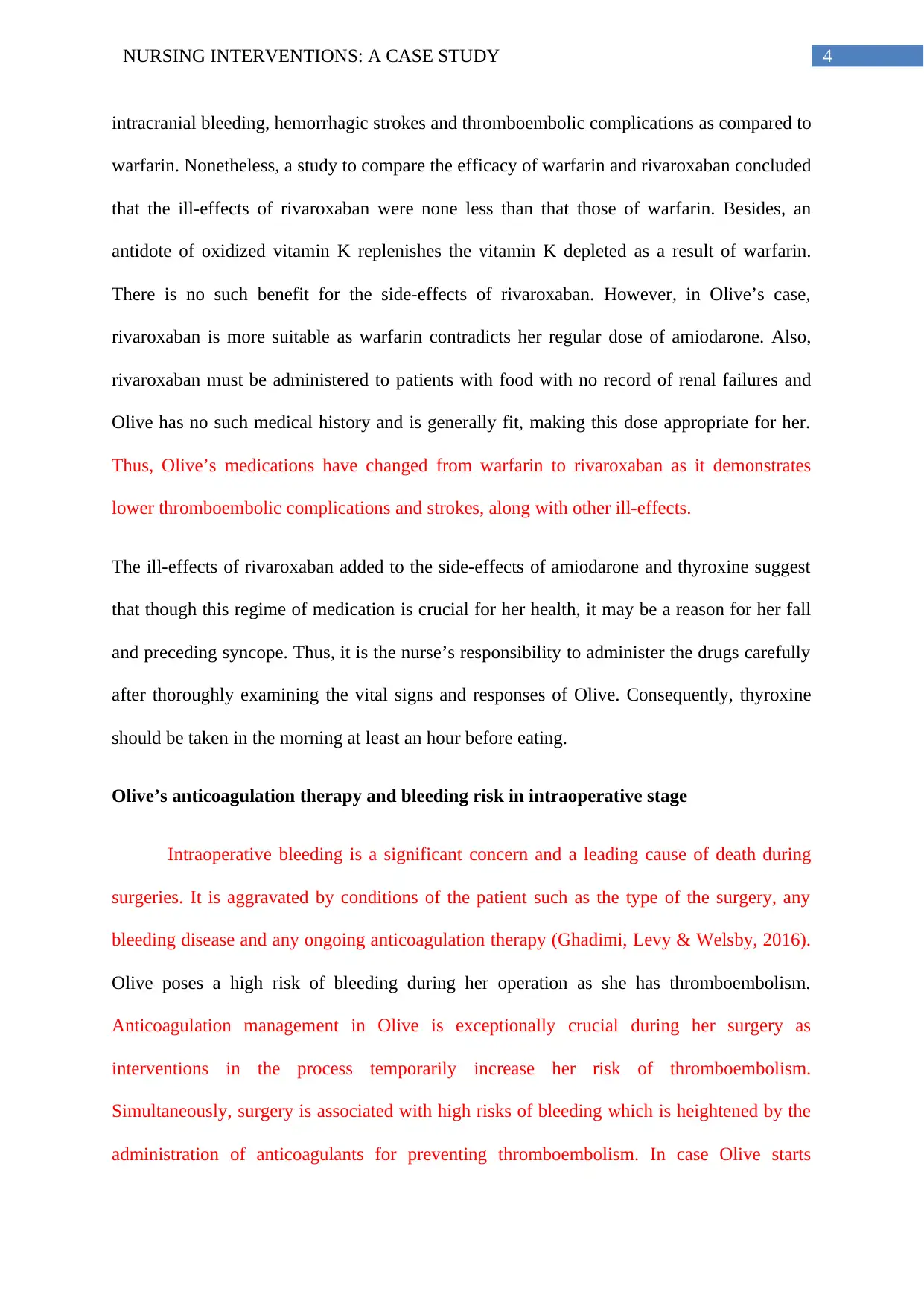
4NURSING INTERVENTIONS: A CASE STUDY
intracranial bleeding, hemorrhagic strokes and thromboembolic complications as compared to
warfarin. Nonetheless, a study to compare the efficacy of warfarin and rivaroxaban concluded
that the ill-effects of rivaroxaban were none less than that those of warfarin. Besides, an
antidote of oxidized vitamin K replenishes the vitamin K depleted as a result of warfarin.
There is no such benefit for the side-effects of rivaroxaban. However, in Olive’s case,
rivaroxaban is more suitable as warfarin contradicts her regular dose of amiodarone. Also,
rivaroxaban must be administered to patients with food with no record of renal failures and
Olive has no such medical history and is generally fit, making this dose appropriate for her.
Thus, Olive’s medications have changed from warfarin to rivaroxaban as it demonstrates
lower thromboembolic complications and strokes, along with other ill-effects.
The ill-effects of rivaroxaban added to the side-effects of amiodarone and thyroxine suggest
that though this regime of medication is crucial for her health, it may be a reason for her fall
and preceding syncope. Thus, it is the nurse’s responsibility to administer the drugs carefully
after thoroughly examining the vital signs and responses of Olive. Consequently, thyroxine
should be taken in the morning at least an hour before eating.
Olive’s anticoagulation therapy and bleeding risk in intraoperative stage
Intraoperative bleeding is a significant concern and a leading cause of death during
surgeries. It is aggravated by conditions of the patient such as the type of the surgery, any
bleeding disease and any ongoing anticoagulation therapy (Ghadimi, Levy & Welsby, 2016).
Olive poses a high risk of bleeding during her operation as she has thromboembolism.
Anticoagulation management in Olive is exceptionally crucial during her surgery as
interventions in the process temporarily increase her risk of thromboembolism.
Simultaneously, surgery is associated with high risks of bleeding which is heightened by the
administration of anticoagulants for preventing thromboembolism. In case Olive starts
intracranial bleeding, hemorrhagic strokes and thromboembolic complications as compared to
warfarin. Nonetheless, a study to compare the efficacy of warfarin and rivaroxaban concluded
that the ill-effects of rivaroxaban were none less than that those of warfarin. Besides, an
antidote of oxidized vitamin K replenishes the vitamin K depleted as a result of warfarin.
There is no such benefit for the side-effects of rivaroxaban. However, in Olive’s case,
rivaroxaban is more suitable as warfarin contradicts her regular dose of amiodarone. Also,
rivaroxaban must be administered to patients with food with no record of renal failures and
Olive has no such medical history and is generally fit, making this dose appropriate for her.
Thus, Olive’s medications have changed from warfarin to rivaroxaban as it demonstrates
lower thromboembolic complications and strokes, along with other ill-effects.
The ill-effects of rivaroxaban added to the side-effects of amiodarone and thyroxine suggest
that though this regime of medication is crucial for her health, it may be a reason for her fall
and preceding syncope. Thus, it is the nurse’s responsibility to administer the drugs carefully
after thoroughly examining the vital signs and responses of Olive. Consequently, thyroxine
should be taken in the morning at least an hour before eating.
Olive’s anticoagulation therapy and bleeding risk in intraoperative stage
Intraoperative bleeding is a significant concern and a leading cause of death during
surgeries. It is aggravated by conditions of the patient such as the type of the surgery, any
bleeding disease and any ongoing anticoagulation therapy (Ghadimi, Levy & Welsby, 2016).
Olive poses a high risk of bleeding during her operation as she has thromboembolism.
Anticoagulation management in Olive is exceptionally crucial during her surgery as
interventions in the process temporarily increase her risk of thromboembolism.
Simultaneously, surgery is associated with high risks of bleeding which is heightened by the
administration of anticoagulants for preventing thromboembolism. In case Olive starts
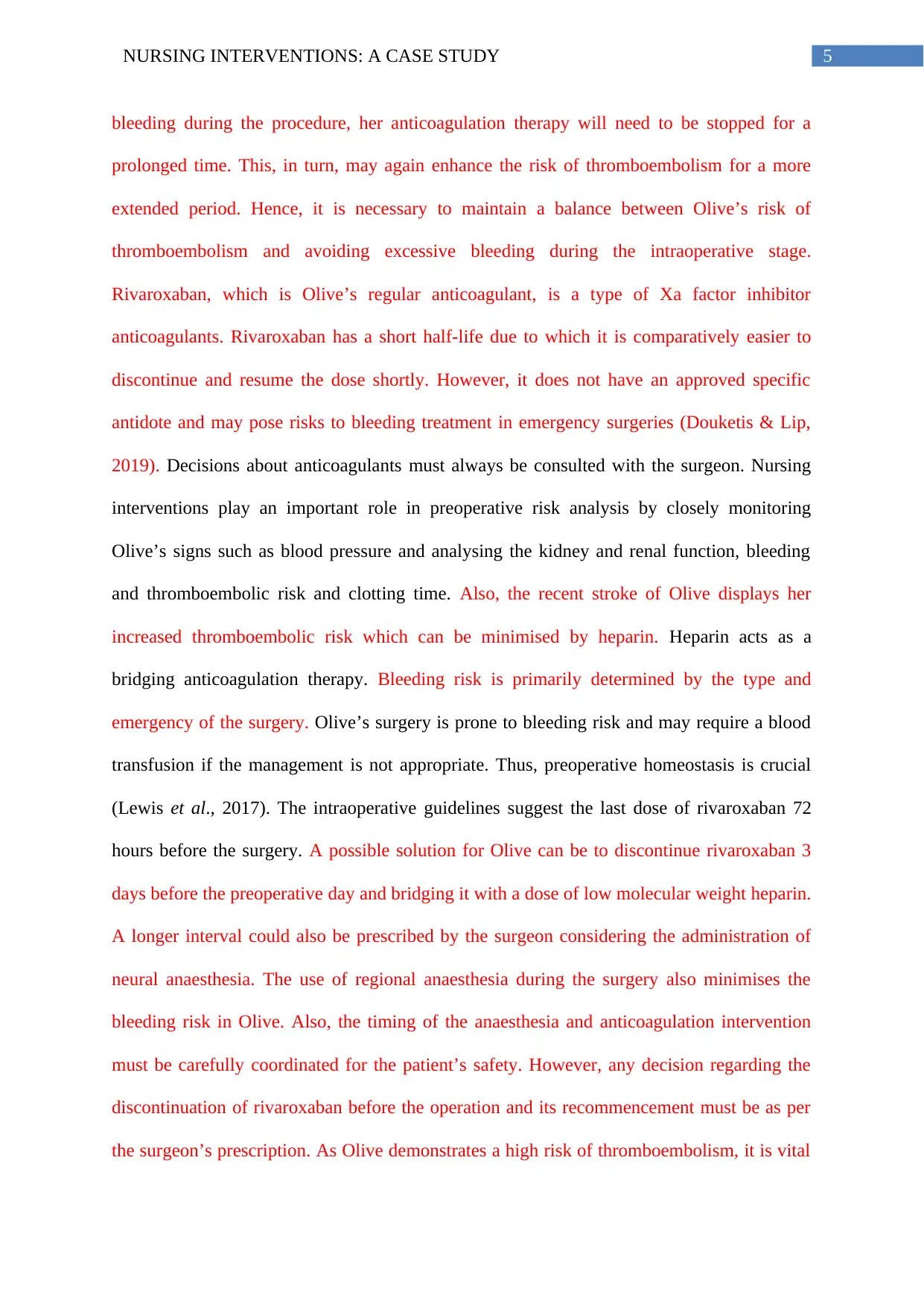
5NURSING INTERVENTIONS: A CASE STUDY
bleeding during the procedure, her anticoagulation therapy will need to be stopped for a
prolonged time. This, in turn, may again enhance the risk of thromboembolism for a more
extended period. Hence, it is necessary to maintain a balance between Olive’s risk of
thromboembolism and avoiding excessive bleeding during the intraoperative stage.
Rivaroxaban, which is Olive’s regular anticoagulant, is a type of Xa factor inhibitor
anticoagulants. Rivaroxaban has a short half-life due to which it is comparatively easier to
discontinue and resume the dose shortly. However, it does not have an approved specific
antidote and may pose risks to bleeding treatment in emergency surgeries (Douketis & Lip,
2019). Decisions about anticoagulants must always be consulted with the surgeon. Nursing
interventions play an important role in preoperative risk analysis by closely monitoring
Olive’s signs such as blood pressure and analysing the kidney and renal function, bleeding
and thromboembolic risk and clotting time. Also, the recent stroke of Olive displays her
increased thromboembolic risk which can be minimised by heparin. Heparin acts as a
bridging anticoagulation therapy. Bleeding risk is primarily determined by the type and
emergency of the surgery. Olive’s surgery is prone to bleeding risk and may require a blood
transfusion if the management is not appropriate. Thus, preoperative homeostasis is crucial
(Lewis et al., 2017). The intraoperative guidelines suggest the last dose of rivaroxaban 72
hours before the surgery. A possible solution for Olive can be to discontinue rivaroxaban 3
days before the preoperative day and bridging it with a dose of low molecular weight heparin.
A longer interval could also be prescribed by the surgeon considering the administration of
neural anaesthesia. The use of regional anaesthesia during the surgery also minimises the
bleeding risk in Olive. Also, the timing of the anaesthesia and anticoagulation intervention
must be carefully coordinated for the patient’s safety. However, any decision regarding the
discontinuation of rivaroxaban before the operation and its recommencement must be as per
the surgeon’s prescription. As Olive demonstrates a high risk of thromboembolism, it is vital
bleeding during the procedure, her anticoagulation therapy will need to be stopped for a
prolonged time. This, in turn, may again enhance the risk of thromboembolism for a more
extended period. Hence, it is necessary to maintain a balance between Olive’s risk of
thromboembolism and avoiding excessive bleeding during the intraoperative stage.
Rivaroxaban, which is Olive’s regular anticoagulant, is a type of Xa factor inhibitor
anticoagulants. Rivaroxaban has a short half-life due to which it is comparatively easier to
discontinue and resume the dose shortly. However, it does not have an approved specific
antidote and may pose risks to bleeding treatment in emergency surgeries (Douketis & Lip,
2019). Decisions about anticoagulants must always be consulted with the surgeon. Nursing
interventions play an important role in preoperative risk analysis by closely monitoring
Olive’s signs such as blood pressure and analysing the kidney and renal function, bleeding
and thromboembolic risk and clotting time. Also, the recent stroke of Olive displays her
increased thromboembolic risk which can be minimised by heparin. Heparin acts as a
bridging anticoagulation therapy. Bleeding risk is primarily determined by the type and
emergency of the surgery. Olive’s surgery is prone to bleeding risk and may require a blood
transfusion if the management is not appropriate. Thus, preoperative homeostasis is crucial
(Lewis et al., 2017). The intraoperative guidelines suggest the last dose of rivaroxaban 72
hours before the surgery. A possible solution for Olive can be to discontinue rivaroxaban 3
days before the preoperative day and bridging it with a dose of low molecular weight heparin.
A longer interval could also be prescribed by the surgeon considering the administration of
neural anaesthesia. The use of regional anaesthesia during the surgery also minimises the
bleeding risk in Olive. Also, the timing of the anaesthesia and anticoagulation intervention
must be carefully coordinated for the patient’s safety. However, any decision regarding the
discontinuation of rivaroxaban before the operation and its recommencement must be as per
the surgeon’s prescription. As Olive demonstrates a high risk of thromboembolism, it is vital
⊘ This is a preview!⊘
Do you want full access?
Subscribe today to unlock all pages.

Trusted by 1+ million students worldwide
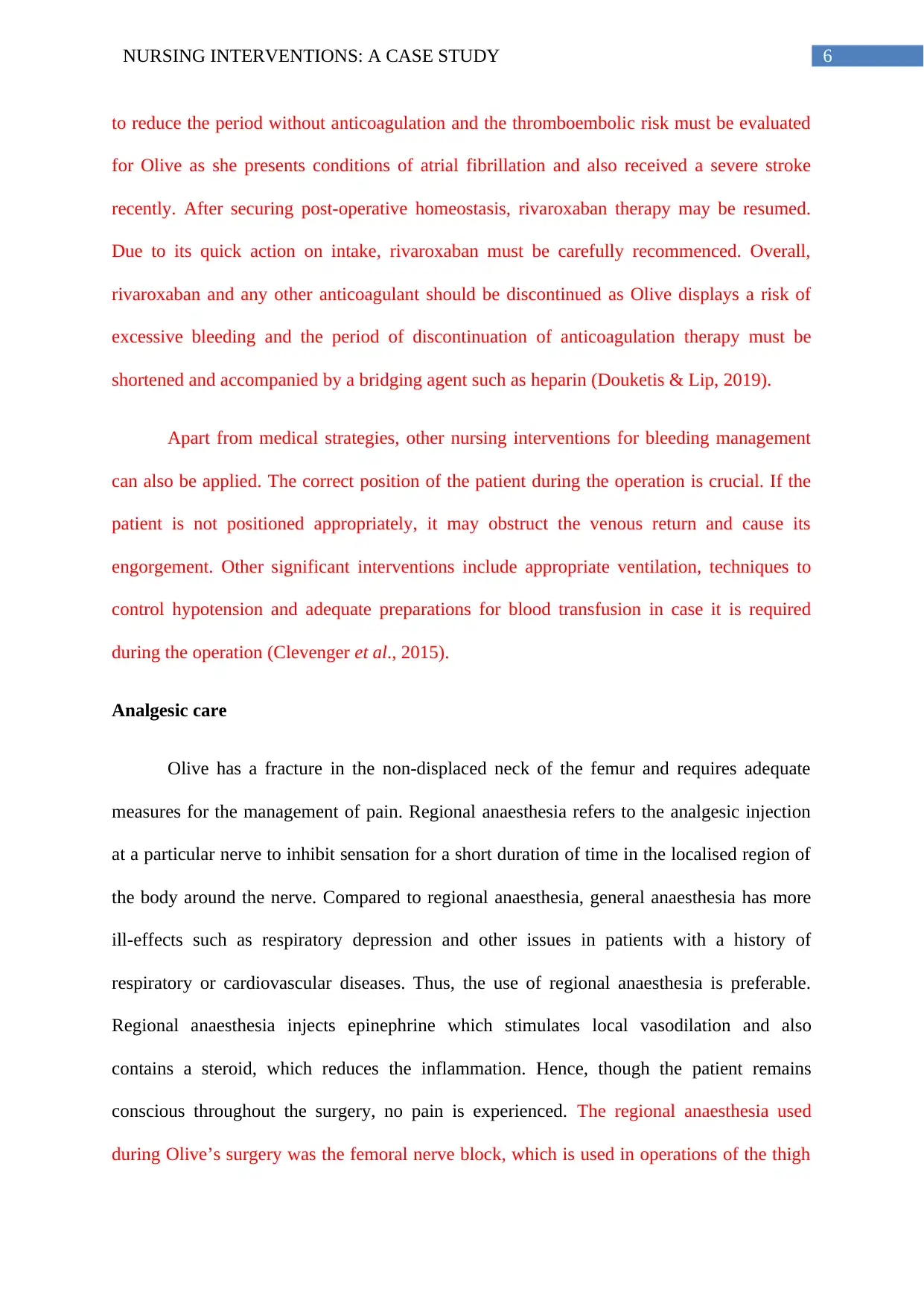
6NURSING INTERVENTIONS: A CASE STUDY
to reduce the period without anticoagulation and the thromboembolic risk must be evaluated
for Olive as she presents conditions of atrial fibrillation and also received a severe stroke
recently. After securing post-operative homeostasis, rivaroxaban therapy may be resumed.
Due to its quick action on intake, rivaroxaban must be carefully recommenced. Overall,
rivaroxaban and any other anticoagulant should be discontinued as Olive displays a risk of
excessive bleeding and the period of discontinuation of anticoagulation therapy must be
shortened and accompanied by a bridging agent such as heparin (Douketis & Lip, 2019).
Apart from medical strategies, other nursing interventions for bleeding management
can also be applied. The correct position of the patient during the operation is crucial. If the
patient is not positioned appropriately, it may obstruct the venous return and cause its
engorgement. Other significant interventions include appropriate ventilation, techniques to
control hypotension and adequate preparations for blood transfusion in case it is required
during the operation (Clevenger et al., 2015).
Analgesic care
Olive has a fracture in the non-displaced neck of the femur and requires adequate
measures for the management of pain. Regional anaesthesia refers to the analgesic injection
at a particular nerve to inhibit sensation for a short duration of time in the localised region of
the body around the nerve. Compared to regional anaesthesia, general anaesthesia has more
ill-effects such as respiratory depression and other issues in patients with a history of
respiratory or cardiovascular diseases. Thus, the use of regional anaesthesia is preferable.
Regional anaesthesia injects epinephrine which stimulates local vasodilation and also
contains a steroid, which reduces the inflammation. Hence, though the patient remains
conscious throughout the surgery, no pain is experienced. The regional anaesthesia used
during Olive’s surgery was the femoral nerve block, which is used in operations of the thigh
to reduce the period without anticoagulation and the thromboembolic risk must be evaluated
for Olive as she presents conditions of atrial fibrillation and also received a severe stroke
recently. After securing post-operative homeostasis, rivaroxaban therapy may be resumed.
Due to its quick action on intake, rivaroxaban must be carefully recommenced. Overall,
rivaroxaban and any other anticoagulant should be discontinued as Olive displays a risk of
excessive bleeding and the period of discontinuation of anticoagulation therapy must be
shortened and accompanied by a bridging agent such as heparin (Douketis & Lip, 2019).
Apart from medical strategies, other nursing interventions for bleeding management
can also be applied. The correct position of the patient during the operation is crucial. If the
patient is not positioned appropriately, it may obstruct the venous return and cause its
engorgement. Other significant interventions include appropriate ventilation, techniques to
control hypotension and adequate preparations for blood transfusion in case it is required
during the operation (Clevenger et al., 2015).
Analgesic care
Olive has a fracture in the non-displaced neck of the femur and requires adequate
measures for the management of pain. Regional anaesthesia refers to the analgesic injection
at a particular nerve to inhibit sensation for a short duration of time in the localised region of
the body around the nerve. Compared to regional anaesthesia, general anaesthesia has more
ill-effects such as respiratory depression and other issues in patients with a history of
respiratory or cardiovascular diseases. Thus, the use of regional anaesthesia is preferable.
Regional anaesthesia injects epinephrine which stimulates local vasodilation and also
contains a steroid, which reduces the inflammation. Hence, though the patient remains
conscious throughout the surgery, no pain is experienced. The regional anaesthesia used
during Olive’s surgery was the femoral nerve block, which is used in operations of the thigh
Paraphrase This Document
Need a fresh take? Get an instant paraphrase of this document with our AI Paraphraser
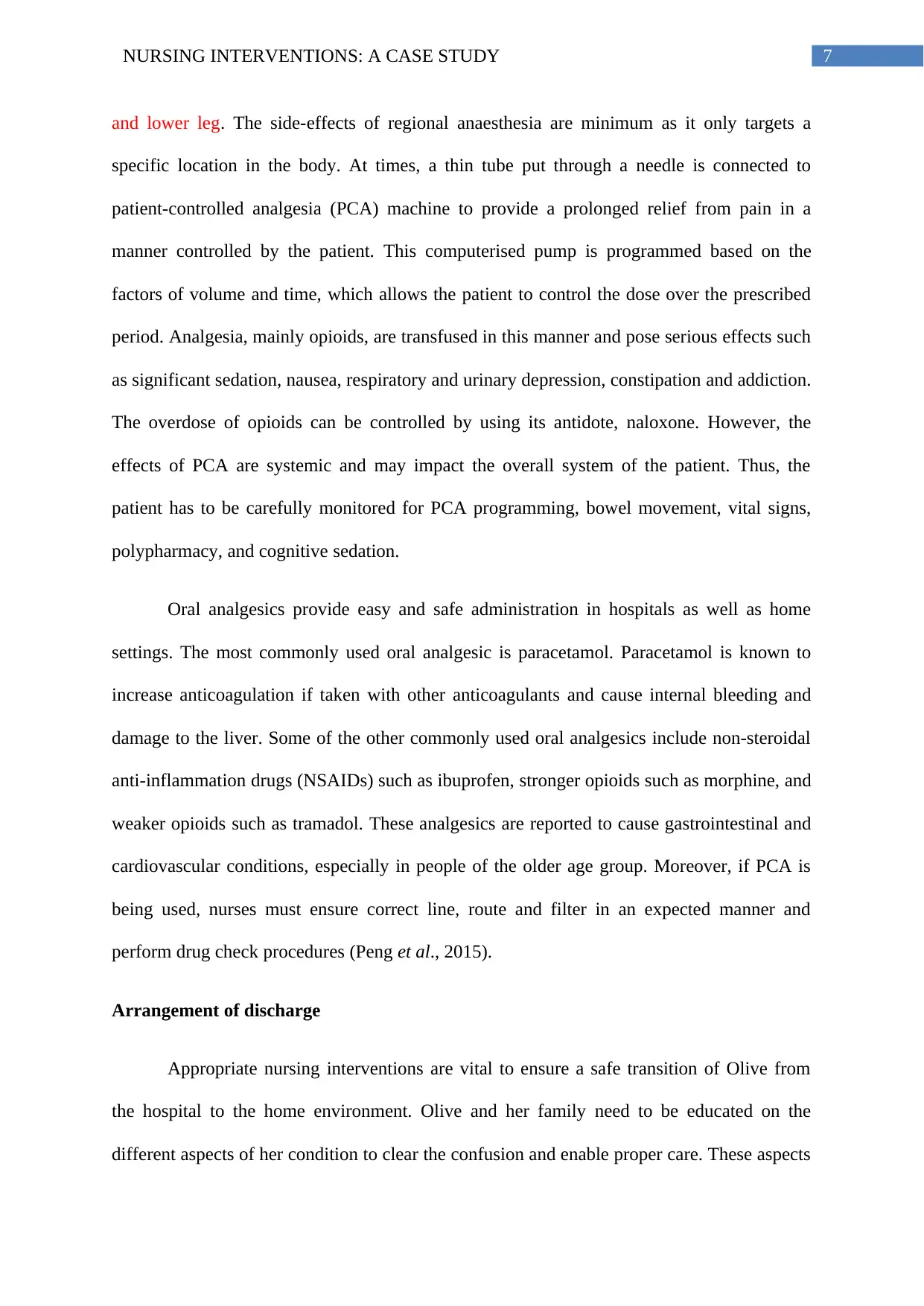
7NURSING INTERVENTIONS: A CASE STUDY
and lower leg. The side-effects of regional anaesthesia are minimum as it only targets a
specific location in the body. At times, a thin tube put through a needle is connected to
patient-controlled analgesia (PCA) machine to provide a prolonged relief from pain in a
manner controlled by the patient. This computerised pump is programmed based on the
factors of volume and time, which allows the patient to control the dose over the prescribed
period. Analgesia, mainly opioids, are transfused in this manner and pose serious effects such
as significant sedation, nausea, respiratory and urinary depression, constipation and addiction.
The overdose of opioids can be controlled by using its antidote, naloxone. However, the
effects of PCA are systemic and may impact the overall system of the patient. Thus, the
patient has to be carefully monitored for PCA programming, bowel movement, vital signs,
polypharmacy, and cognitive sedation.
Oral analgesics provide easy and safe administration in hospitals as well as home
settings. The most commonly used oral analgesic is paracetamol. Paracetamol is known to
increase anticoagulation if taken with other anticoagulants and cause internal bleeding and
damage to the liver. Some of the other commonly used oral analgesics include non-steroidal
anti-inflammation drugs (NSAIDs) such as ibuprofen, stronger opioids such as morphine, and
weaker opioids such as tramadol. These analgesics are reported to cause gastrointestinal and
cardiovascular conditions, especially in people of the older age group. Moreover, if PCA is
being used, nurses must ensure correct line, route and filter in an expected manner and
perform drug check procedures (Peng et al., 2015).
Arrangement of discharge
Appropriate nursing interventions are vital to ensure a safe transition of Olive from
the hospital to the home environment. Olive and her family need to be educated on the
different aspects of her condition to clear the confusion and enable proper care. These aspects
and lower leg. The side-effects of regional anaesthesia are minimum as it only targets a
specific location in the body. At times, a thin tube put through a needle is connected to
patient-controlled analgesia (PCA) machine to provide a prolonged relief from pain in a
manner controlled by the patient. This computerised pump is programmed based on the
factors of volume and time, which allows the patient to control the dose over the prescribed
period. Analgesia, mainly opioids, are transfused in this manner and pose serious effects such
as significant sedation, nausea, respiratory and urinary depression, constipation and addiction.
The overdose of opioids can be controlled by using its antidote, naloxone. However, the
effects of PCA are systemic and may impact the overall system of the patient. Thus, the
patient has to be carefully monitored for PCA programming, bowel movement, vital signs,
polypharmacy, and cognitive sedation.
Oral analgesics provide easy and safe administration in hospitals as well as home
settings. The most commonly used oral analgesic is paracetamol. Paracetamol is known to
increase anticoagulation if taken with other anticoagulants and cause internal bleeding and
damage to the liver. Some of the other commonly used oral analgesics include non-steroidal
anti-inflammation drugs (NSAIDs) such as ibuprofen, stronger opioids such as morphine, and
weaker opioids such as tramadol. These analgesics are reported to cause gastrointestinal and
cardiovascular conditions, especially in people of the older age group. Moreover, if PCA is
being used, nurses must ensure correct line, route and filter in an expected manner and
perform drug check procedures (Peng et al., 2015).
Arrangement of discharge
Appropriate nursing interventions are vital to ensure a safe transition of Olive from
the hospital to the home environment. Olive and her family need to be educated on the
different aspects of her condition to clear the confusion and enable proper care. These aspects
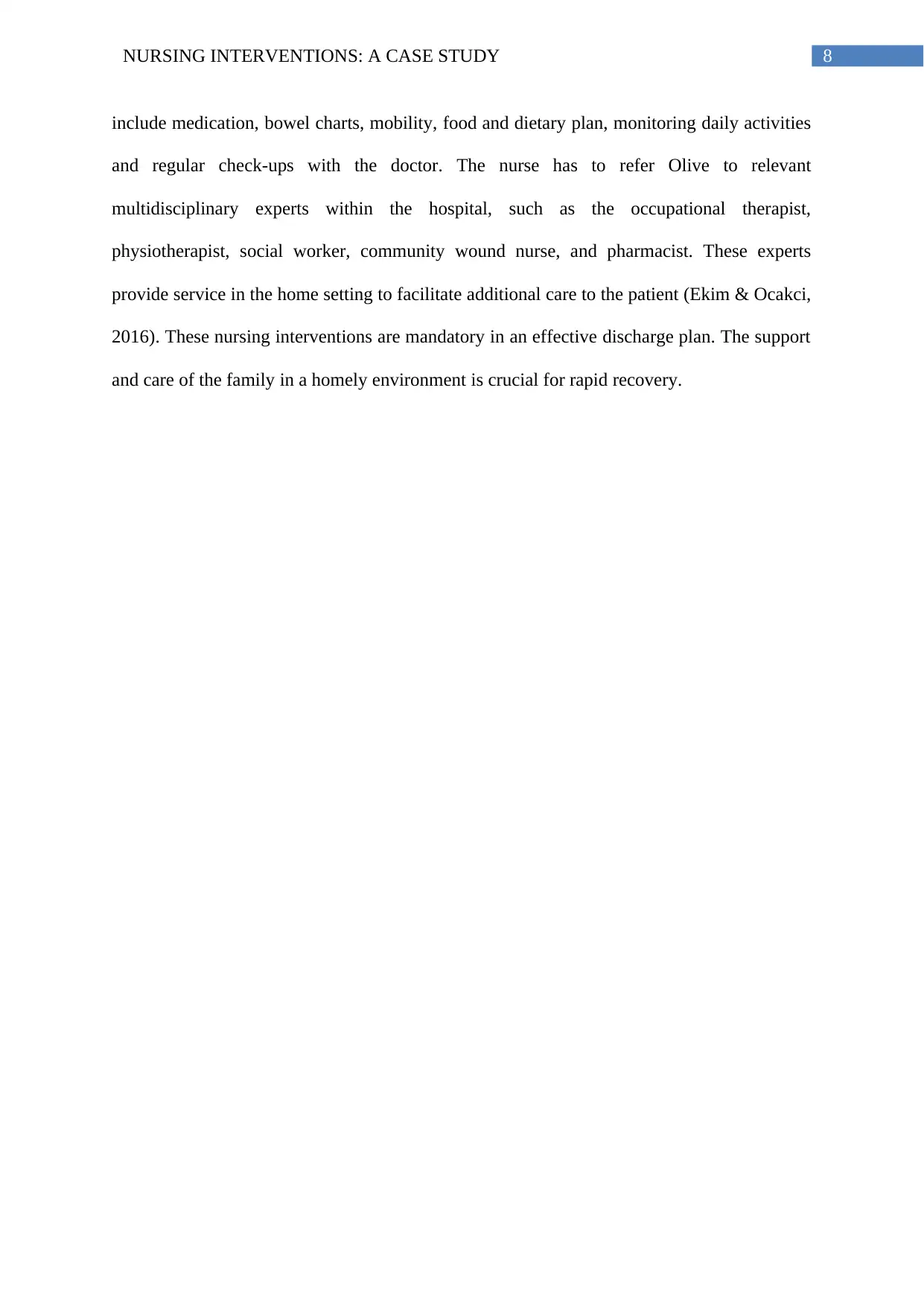
8NURSING INTERVENTIONS: A CASE STUDY
include medication, bowel charts, mobility, food and dietary plan, monitoring daily activities
and regular check-ups with the doctor. The nurse has to refer Olive to relevant
multidisciplinary experts within the hospital, such as the occupational therapist,
physiotherapist, social worker, community wound nurse, and pharmacist. These experts
provide service in the home setting to facilitate additional care to the patient (Ekim & Ocakci,
2016). These nursing interventions are mandatory in an effective discharge plan. The support
and care of the family in a homely environment is crucial for rapid recovery.
include medication, bowel charts, mobility, food and dietary plan, monitoring daily activities
and regular check-ups with the doctor. The nurse has to refer Olive to relevant
multidisciplinary experts within the hospital, such as the occupational therapist,
physiotherapist, social worker, community wound nurse, and pharmacist. These experts
provide service in the home setting to facilitate additional care to the patient (Ekim & Ocakci,
2016). These nursing interventions are mandatory in an effective discharge plan. The support
and care of the family in a homely environment is crucial for rapid recovery.
⊘ This is a preview!⊘
Do you want full access?
Subscribe today to unlock all pages.

Trusted by 1+ million students worldwide
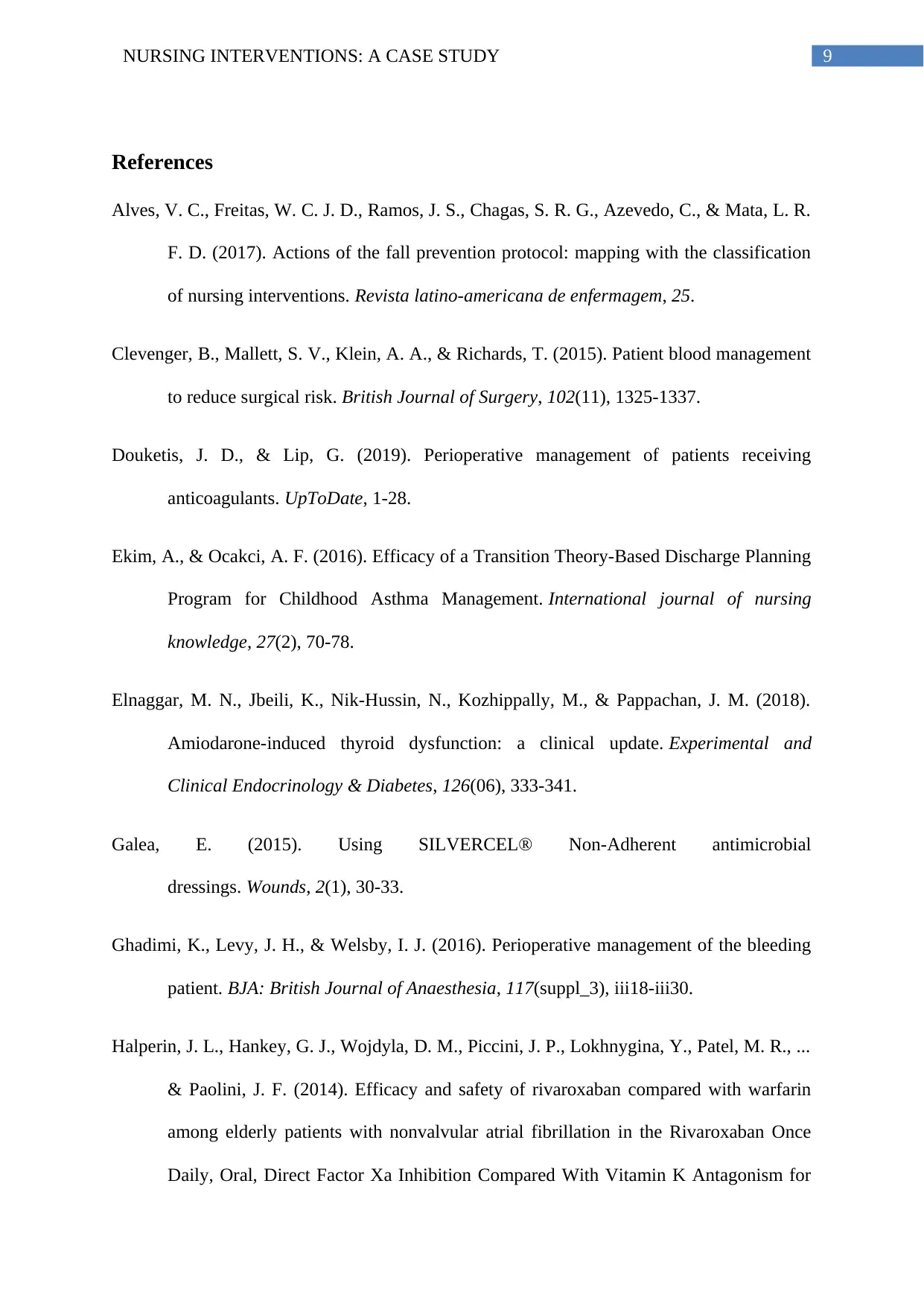
9NURSING INTERVENTIONS: A CASE STUDY
References
Alves, V. C., Freitas, W. C. J. D., Ramos, J. S., Chagas, S. R. G., Azevedo, C., & Mata, L. R.
F. D. (2017). Actions of the fall prevention protocol: mapping with the classification
of nursing interventions. Revista latino-americana de enfermagem, 25.
Clevenger, B., Mallett, S. V., Klein, A. A., & Richards, T. (2015). Patient blood management
to reduce surgical risk. British Journal of Surgery, 102(11), 1325-1337.
Douketis, J. D., & Lip, G. (2019). Perioperative management of patients receiving
anticoagulants. UpToDate, 1-28.
Ekim, A., & Ocakci, A. F. (2016). Efficacy of a Transition Theory‐Based Discharge Planning
Program for Childhood Asthma Management. International journal of nursing
knowledge, 27(2), 70-78.
Elnaggar, M. N., Jbeili, K., Nik-Hussin, N., Kozhippally, M., & Pappachan, J. M. (2018).
Amiodarone-induced thyroid dysfunction: a clinical update. Experimental and
Clinical Endocrinology & Diabetes, 126(06), 333-341.
Galea, E. (2015). Using SILVERCEL® Non-Adherent antimicrobial
dressings. Wounds, 2(1), 30-33.
Ghadimi, K., Levy, J. H., & Welsby, I. J. (2016). Perioperative management of the bleeding
patient. BJA: British Journal of Anaesthesia, 117(suppl_3), iii18-iii30.
Halperin, J. L., Hankey, G. J., Wojdyla, D. M., Piccini, J. P., Lokhnygina, Y., Patel, M. R., ...
& Paolini, J. F. (2014). Efficacy and safety of rivaroxaban compared with warfarin
among elderly patients with nonvalvular atrial fibrillation in the Rivaroxaban Once
Daily, Oral, Direct Factor Xa Inhibition Compared With Vitamin K Antagonism for
References
Alves, V. C., Freitas, W. C. J. D., Ramos, J. S., Chagas, S. R. G., Azevedo, C., & Mata, L. R.
F. D. (2017). Actions of the fall prevention protocol: mapping with the classification
of nursing interventions. Revista latino-americana de enfermagem, 25.
Clevenger, B., Mallett, S. V., Klein, A. A., & Richards, T. (2015). Patient blood management
to reduce surgical risk. British Journal of Surgery, 102(11), 1325-1337.
Douketis, J. D., & Lip, G. (2019). Perioperative management of patients receiving
anticoagulants. UpToDate, 1-28.
Ekim, A., & Ocakci, A. F. (2016). Efficacy of a Transition Theory‐Based Discharge Planning
Program for Childhood Asthma Management. International journal of nursing
knowledge, 27(2), 70-78.
Elnaggar, M. N., Jbeili, K., Nik-Hussin, N., Kozhippally, M., & Pappachan, J. M. (2018).
Amiodarone-induced thyroid dysfunction: a clinical update. Experimental and
Clinical Endocrinology & Diabetes, 126(06), 333-341.
Galea, E. (2015). Using SILVERCEL® Non-Adherent antimicrobial
dressings. Wounds, 2(1), 30-33.
Ghadimi, K., Levy, J. H., & Welsby, I. J. (2016). Perioperative management of the bleeding
patient. BJA: British Journal of Anaesthesia, 117(suppl_3), iii18-iii30.
Halperin, J. L., Hankey, G. J., Wojdyla, D. M., Piccini, J. P., Lokhnygina, Y., Patel, M. R., ...
& Paolini, J. F. (2014). Efficacy and safety of rivaroxaban compared with warfarin
among elderly patients with nonvalvular atrial fibrillation in the Rivaroxaban Once
Daily, Oral, Direct Factor Xa Inhibition Compared With Vitamin K Antagonism for
Paraphrase This Document
Need a fresh take? Get an instant paraphrase of this document with our AI Paraphraser
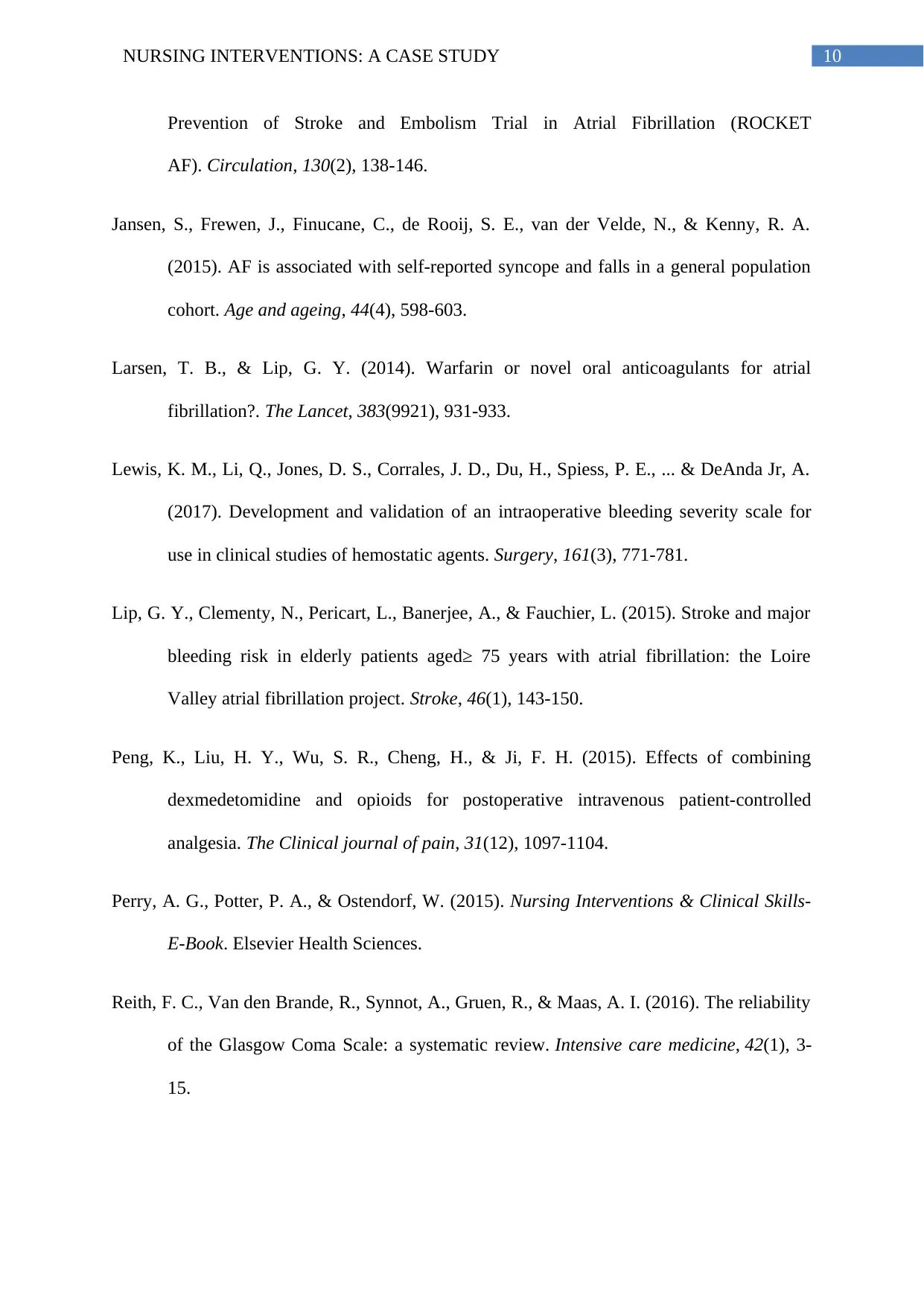
10NURSING INTERVENTIONS: A CASE STUDY
Prevention of Stroke and Embolism Trial in Atrial Fibrillation (ROCKET
AF). Circulation, 130(2), 138-146.
Jansen, S., Frewen, J., Finucane, C., de Rooij, S. E., van der Velde, N., & Kenny, R. A.
(2015). AF is associated with self-reported syncope and falls in a general population
cohort. Age and ageing, 44(4), 598-603.
Larsen, T. B., & Lip, G. Y. (2014). Warfarin or novel oral anticoagulants for atrial
fibrillation?. The Lancet, 383(9921), 931-933.
Lewis, K. M., Li, Q., Jones, D. S., Corrales, J. D., Du, H., Spiess, P. E., ... & DeAnda Jr, A.
(2017). Development and validation of an intraoperative bleeding severity scale for
use in clinical studies of hemostatic agents. Surgery, 161(3), 771-781.
Lip, G. Y., Clementy, N., Pericart, L., Banerjee, A., & Fauchier, L. (2015). Stroke and major
bleeding risk in elderly patients aged≥ 75 years with atrial fibrillation: the Loire
Valley atrial fibrillation project. Stroke, 46(1), 143-150.
Peng, K., Liu, H. Y., Wu, S. R., Cheng, H., & Ji, F. H. (2015). Effects of combining
dexmedetomidine and opioids for postoperative intravenous patient-controlled
analgesia. The Clinical journal of pain, 31(12), 1097-1104.
Perry, A. G., Potter, P. A., & Ostendorf, W. (2015). Nursing Interventions & Clinical Skills-
E-Book. Elsevier Health Sciences.
Reith, F. C., Van den Brande, R., Synnot, A., Gruen, R., & Maas, A. I. (2016). The reliability
of the Glasgow Coma Scale: a systematic review. Intensive care medicine, 42(1), 3-
15.
Prevention of Stroke and Embolism Trial in Atrial Fibrillation (ROCKET
AF). Circulation, 130(2), 138-146.
Jansen, S., Frewen, J., Finucane, C., de Rooij, S. E., van der Velde, N., & Kenny, R. A.
(2015). AF is associated with self-reported syncope and falls in a general population
cohort. Age and ageing, 44(4), 598-603.
Larsen, T. B., & Lip, G. Y. (2014). Warfarin or novel oral anticoagulants for atrial
fibrillation?. The Lancet, 383(9921), 931-933.
Lewis, K. M., Li, Q., Jones, D. S., Corrales, J. D., Du, H., Spiess, P. E., ... & DeAnda Jr, A.
(2017). Development and validation of an intraoperative bleeding severity scale for
use in clinical studies of hemostatic agents. Surgery, 161(3), 771-781.
Lip, G. Y., Clementy, N., Pericart, L., Banerjee, A., & Fauchier, L. (2015). Stroke and major
bleeding risk in elderly patients aged≥ 75 years with atrial fibrillation: the Loire
Valley atrial fibrillation project. Stroke, 46(1), 143-150.
Peng, K., Liu, H. Y., Wu, S. R., Cheng, H., & Ji, F. H. (2015). Effects of combining
dexmedetomidine and opioids for postoperative intravenous patient-controlled
analgesia. The Clinical journal of pain, 31(12), 1097-1104.
Perry, A. G., Potter, P. A., & Ostendorf, W. (2015). Nursing Interventions & Clinical Skills-
E-Book. Elsevier Health Sciences.
Reith, F. C., Van den Brande, R., Synnot, A., Gruen, R., & Maas, A. I. (2016). The reliability
of the Glasgow Coma Scale: a systematic review. Intensive care medicine, 42(1), 3-
15.

11NURSING INTERVENTIONS: A CASE STUDY
Song, Z., Wu, H., Cao, H., Yang, S., Tang, M., & Qin, L. (2018). Routine coagulation test
abnormalities caused by rivaroxaban: a case report. Medicine, 97(45).
Wold, J. F. H., Ruiter, J. H., Cornel, J. H., Vogels, R. L. C., & Jansen, R. W. M. M. (2015). A
multidisciplinary care pathway for the evaluation of falls and syncope in geriatric
patients. European Geriatric Medicine, 6(5), 487-494.
Song, Z., Wu, H., Cao, H., Yang, S., Tang, M., & Qin, L. (2018). Routine coagulation test
abnormalities caused by rivaroxaban: a case report. Medicine, 97(45).
Wold, J. F. H., Ruiter, J. H., Cornel, J. H., Vogels, R. L. C., & Jansen, R. W. M. M. (2015). A
multidisciplinary care pathway for the evaluation of falls and syncope in geriatric
patients. European Geriatric Medicine, 6(5), 487-494.
⊘ This is a preview!⊘
Do you want full access?
Subscribe today to unlock all pages.

Trusted by 1+ million students worldwide
1 out of 12
Related Documents
Your All-in-One AI-Powered Toolkit for Academic Success.
+13062052269
info@desklib.com
Available 24*7 on WhatsApp / Email
![[object Object]](/_next/static/media/star-bottom.7253800d.svg)
Unlock your academic potential
Copyright © 2020–2025 A2Z Services. All Rights Reserved. Developed and managed by ZUCOL.





